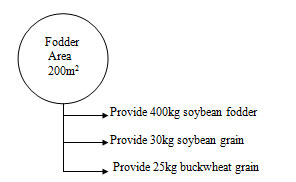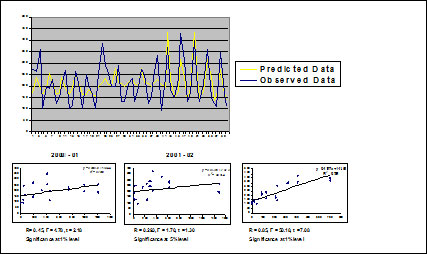- Goat Farming
- Herd strength: 30 Local Assam Goats having average body weights 15kg.
In-put:
- Fodder @ 3.5kg/d/head for 7 months in rainy season = 22 tone
- Fodder for lean period for 5 months = 16 tone
Total = 38 tone
Model for Fodder Production

- Out side support in the form of concentrate (@ 50g/d/head) needed = 5.5 Qtl.
- These Livestock will provide 2 tone FYM (having 55% DM) and 3,000 liters urine to enrich the soil.
- Forage Based Rabbit Farming
Legume forage like soybean/ rice bean etc. worked as maintenance ration for adult rabbits. However, these folders can substitute to the level of 50% of total DM intake in grower stage rabbits.
In-put: For 25 Nos. rabbits from weaning to slaughter stage i.e. for 45 days
- Concentrate @ 50g/d/head = 60 kg
- Legume fodder to meet 50% of total DM intake = 400 kg
Fodder Area = 200m2
(Soybean crop for fodder cum grain production and buckwheat in relay)

- The buckwheat grain (25kg) and soybean grain (6kg) make balance ration to feed 10 adult or grower rabbits for 30 days and rest 24kg soybean grain for human consumption.
- The 25 rabbits in 45 days will provide 90kg FYM having 45%DM and 150 liters urine to enrich the soil. Apart from this, soybean crop residue rhizome will add biomass in the system @ 4.25t/ha which increase the nutrient soil status in terms of OM 1.22%, Total N 14.14%, AV. N 4.35%. The P was decrease @ 40.6% in the soil.
Soil characteristics of soybean plot
| Particulars | pH | Organic matter (%) | Total N (%) |
Avail. N (%) |
P (%) | P (kg/ha) |
Actual P (p pm) |
| Initial | 5.52 | 9.56 | 0.195 | 0.022 | 0.0045 | 101.5 | 45.31 |
| After FYM & Lime addition* | 6.02 | 9.81 | 0.198 | 0.023 | 0.0055 | 123.6 | 55.19 |
| After Soybean Harvest | 5.97 | 9.93 | 0.226 | 0.024 | 0.0033 | 73.4 | 32.75 |
*Dry FYM added @ 6t/ha and lime @ 2t/ha
- Sweet Potato Tuber and Soybean Production – A Case study for Pig Feeding
Herd Strength: 10 crossbred weaned piglets
In-puts: From weaning to slaughter stage i.e. for 240 days (Av. Concentrate feed requirement @ 1.5kg/d/head)
i. Out side support:
i. Rice Polish for mixing in the ration @ 12% = 432kg (Rs. 3,456.00)
ii. Mineral mixtures and common salt @ 3% = 108kg (Rs. 4,536.00)
ii. Feed Production at Farm:
i. Sweet potato tuber to meet 60% DM intake = 7.2 tone
ii. Soybean grain to meet 25% DM intake = 9 Qtl.
Model for Feed Production
Area = 0.75 ha

Out-puts:
- Total 60 kg grain/pig in body weight (an average growth rate of 250g/d/head) is worth to Rs. 3,600.00 if consider sale rate @ Rs. 60/kg/body weight.
- The total 10 pigs in 240 days will provide 3.6 tone fresh FYM and 2400 liters urine to enrich the soil.
Technology released from Veterinary Parasitology Division, ICAR Research Complex for NEH Region
2. Problem Identified
The Division of Parasitology, ICAR Research Complex for NEH Region had conducted several survey works for development of databases regarding the status of prevailing parasites in this region and their intermediate host like snail as well as the occurrence of parasitic diseases in relation to different environmental factors.
After completed the survey work, the division started thinking for digitization of survey result and development of software. The basic idea for development of parasite related software was to store the information regarding different parasites as well as differential diagnosis of parasitic infestation in the form of a database and the user can able to retrieve the information from the database according to their choice. Another basic objective for development of software was to incorporate the information regarding morphology, pathogenesis, treatment, diagnosis and control measures of different parasites as well as different techniques for diagnosis of parasitic infection in animals starting from basic parasitological diagnostic techniques to different sophisticated serological techniques. The idea converted into reality after 3 years of research. The software developed by the division is now very helpful for worhers, acdemicians, students and technicians engaged in parasitological research. The software has been revalidated by different premier academic Institute of the country like IIT, Kharagpur, IVRI, Izatnagar, West Bengal University of Animal Science and Fisheries etc.
The epidemiological survey work regarding the prevalence of GI parasites revealed that temperature rang of 20 – 35 0 C and 100% humidity is the most congenial for development of parasitic and non parasitic larval stage in soil ( Soulsby, 1982). Since the region is receiving highest precipitation as compare to global precipitation scenario. The high rainfall as well as prevailing high humidity is the most congenial environmental factor for development of parasitic larva outside the host.and as a result of which almost 80% of cattle and goat in this region was suffering from this infection. The predominant GI parasites identified were Oesophagostomum spp.( 82.5 %) and Bunostomum sp ( 75.5 %) followed by Haemonchus spp. ( 70%), Trichuris spp. ( 69 %), Trichostrongylus spp. ( 64 %) based on the examination of gastrointestinal tract of slaughtered animals.
Studies regarding the seasonal occurrence of parasitic infection showed that egg per gram of faeces (EPG) level was going to be increased during rainy season and reached its peak during the post monsoon period and again it were going to be decreased during winter season. The result of this finding depicted the direct relationship between rain/humidity with EPG level. After analyzing the five years survey result the division developed a prediction model based on different environmental parameters and occurrence of GI parasitic infection in cattle and goat. The analysis revealed a significant correlation (P<0.01) exist between the rainfall and EPG level of parasite. For validation of this prediction model, the division is being collecting the record regarding the occurrence of parasitic infection from different organized farms of State Animal Husbandry Departments.
The division was continuously monitoring the GI parasitic infection in animals for last 5 years using standard faecal sample examination through microscope. Though it is till now the only recommended standard method for monitoring of GI parasitic load in animals but the method has some limitation regarding the sensitivity and specificity. Due to close morphological resemblance between the eggs of different GI parasites, experience and expertise is required for accurate identification. Since floatation and centrifugation of faecal sample using concentrated salt solution is required for isolation of parasitic egg, it is very difficult to isolate the eggs in low level of GI parasitic infection in animals. To overcome this limitation, division has evolved serological based alternate method for accurate identification of different GI parasitic egg in farmers’ filed. This method is based on identification of specific antibody in the sera of infected animal using specific antigen purified in the laboratory. The antigen purified for this purpose is specific for each GI parasites and it is not cross reactive with other GI parasites. The purified antigen is able to identify in low level of specific infection in animals. The antigen used for this purpose purified using different immunological and biochemical techniques. Using this purified antigen a DOT ELISA based diagnostic kit has been developed for monitoring the antibody level of GI parasites in naturally infected animals.
3. Specify the Farming situation for which technology is developed
The North Eastern Hill Region of India is having some unique features as compare to other parts of the country. The region is surrounded by international boundaries with Bangladesh, Myanmar, China, Bhutan and Nepal. The region is having six distinct agro ecological zones with varying altitude starting from 200 m to 3500 m above msl.
Livestock development in the country faces number of constraints related to health, breeding, nutrition and management. The loss due to these constraints is about Rs. 432 billion annually (according to 2002/03 prices). The production loss due to improper health management contribute Rs. 138.3 billion (31.9%) out of total production loss of Rs. 432 billion annually considering all species of animals. Since the main animal population in north eastern hill region consist of cattle, goat, pig and poultry, the losses due to this animals comes to Rs. 112.8 billion ( 26.1%). Considering the world scenario, the production loss of animals due to gastro-intestinal (GI) parasitic infection in animals was at a tune of more than £ 1000 millions annually (Newton and Munn, 1999). It has been found that due to favorable environmental condition prevailing in North Eastern Region, GI parasitic infestation is the major hurdle for production loss in farming community in this region.
4.Crop/ Birds/ Animals etc.
5.Breeds/ Varieties
6.Specify the technology
So from the above discussion it is clear that the division has analysed the problem of parasitic infestation in this region from different angles and several attempts has already being made to develop several technologies to address these issues.
- One of the basic issues of survey of different parasitic infestation had already being successfully addressed and a database driven software developed incorporating the detail information regarding the type of parasitic infestation in this region.

- Second issue of relationship between environmental parameter and parasitic infestation was addressed by development of prediction model correlating rainfall and parasitic infestation.

- Third and most important issue related to type of parasitic infestation in the farmer’s field and their successful control measures was addressed by development of DOT ELISA based diagnostic kit for field level diagnosis of GI parasitic infestation in animals.
